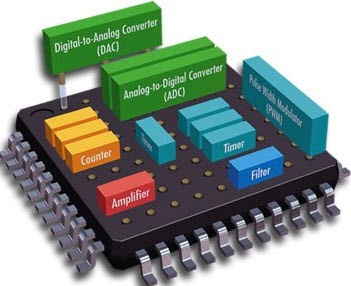
Embedded System
An embedded system is an electronic system that has a software and is embedded in computer hardware. It is programmable or non- programmable depending on the application. An Embedded system is defined as a way of working, organizing, performing single or multiple tasks according to a set of rules.In an embedded system, all the units assemble and work together according to the program. Examples of embedded systems include numerous products such as microwave ovens, washing machine, printers, automobiles, cameras, etc. These systems use microprocessors, microcontrollers as well as processors like DSPs. This article gives an overview of what is an embedded system and types of embedded system.
The important characteristics of an embedded systems are speed, size, power, reliability, accuracy, adaptability. Therefore, when the embedded system performs the operations at high speed, then it can be used for real -time applications. The Size of the system and power consumption should be very low, then the system can be easily adaptable for different situations.
What is an embedded system?
An Embedded system is a combination of computer hardware and software. As with any electronic system, this system requires a hardware platform and that is built with a microprocessor or microcontroller. The Embedded system hardware includes elements like user interface, Input/Output interfaces, display and memory, etc.Generally, an embedded system comprises power supply, processor, memory, timers, serial communication ports and system application specific circuits.
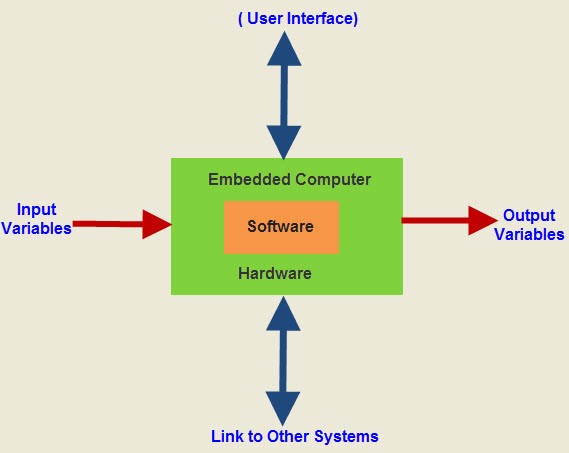
Embedded System
Embedded system software is written in a high-level language, and then compiled to achieve a specific function within a non-volatile memory in the hardware. Embedded system software is designed to keep in view of three limits. They are availability of system memory and processor speed. When the system runs endlessly, there is a need to limit the power dissipation for events like run, stop and wake up.
Embedded Systems Basics
The embedded systems basics include the components of embedded system hardware, embedded system types and several characteristics. An embedded system has three main components: Embedded system hardware, Embedded system software and Operating system.
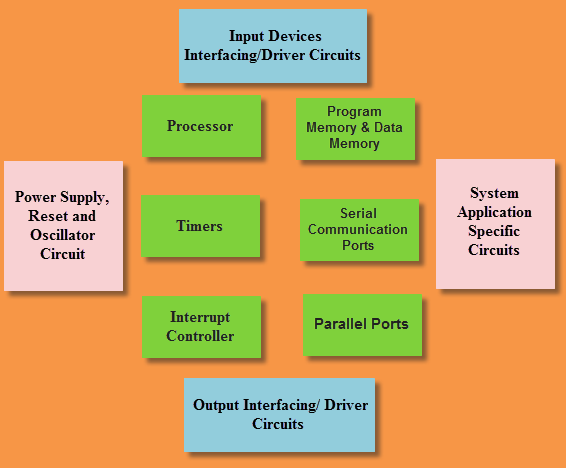
Embedded System Block Diagram
Embedded System Hardware:
As with any electronic system, an embedded system requires a hardware platform on which it performs the operation. Embedded system hardware is built with a microprocessor or microcontroller. The embedded system hardware has elements like input output (I/O) interfaces, user interface, memory and the display. Usually, an embedded system consists of:
- Power Supply
- Processor
- Memory
- Timers
- Serial communication ports
- Output/Output circuits
- System application specific circuits
Embedded System Software:
The embedded system software is written to perform a specific function. It is typically written in a high level format and then compiled down to provide code that can be lodged within a non-volatile memory within the hardware. An embedded system software is designed to keep in view of the three limits:
- Availability of system memory
- Availability of processor’s speed
- When the system runs continuously, there is a need to limit power dissipation for events like stop, run and wake up.
Real Time Operating System
A system is said to be real time, if it is essential to complete its work and deliver its service on time. Real time operating system manages the application software and affords a mechanism to let the processor run. The Real Time operating system is responsible for handling the hardware resources of a computer and host applications which run on the computer.
An RTOS is specially designed to run applications with very precise timing and a high amount of reliability. Especially, this can be important in measurement and industrial automation systems wherein downtime is costly or a program delay could cause a safety hazard.
Memory:
In an embedded system, there are different types of memories. The various forms of memories are presented in the below chart.
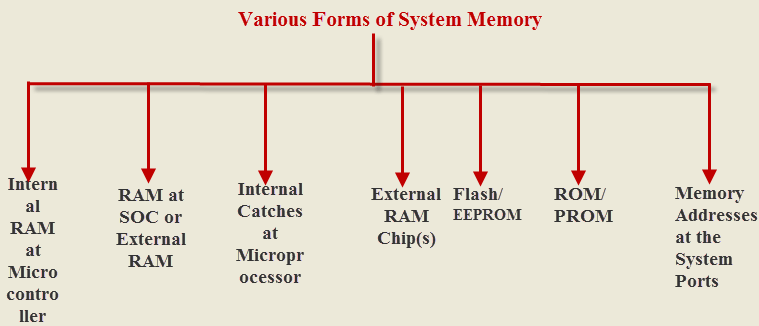
Memory
Processors:
Different processors used in embedded systems are microprocessor, (DSP) Digital Signal Processor, microcontroller, RISC processor, ASIP processor, Arm processor and ASSP processor.
Embedding a Microprocessor
Microprocessor is a general purpose processor, which can be embedded on a VLSI chip. The different streams of microprocessors used in embedded systems are given in the table.
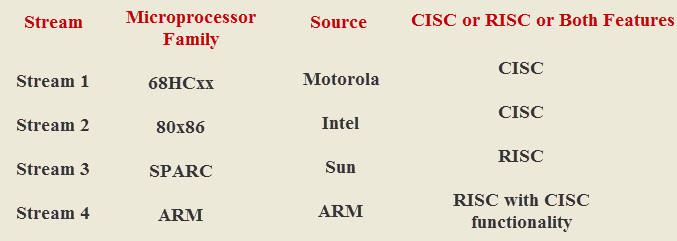
Embedding a Microprocessor
Embedding a Microcontroller:
The different streams of Microcontrollers used in embedded systems are usually among the five streams of families given in the table.
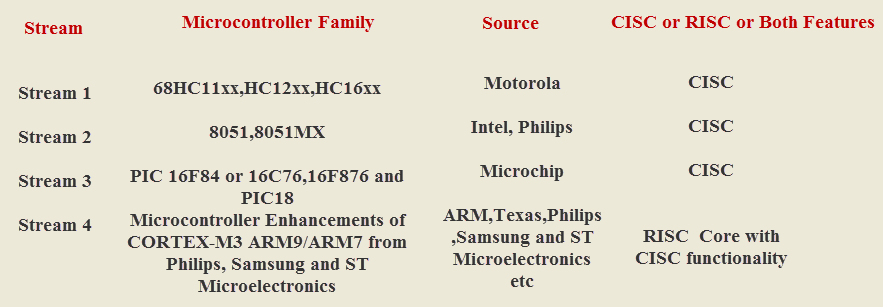
Embedding a Microcontroller
Embedding a DSP:
A digital signal processor is a processor and, it is an essential unit of an embedded system. The DSP applications, are audio, video, multimedia, image processing, DSP modem, HDTV and telecommunication processing systems. These processors are also used in systems for recognizing DNA sequence and image pattern. The different streams of DSPs used in embedded systems are given in the table.
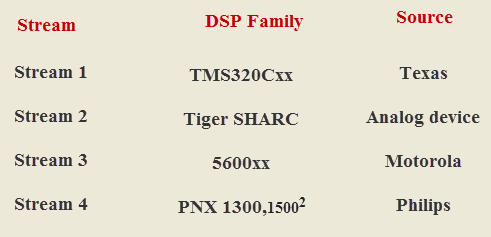
Embedding a DSP
Types of Embedded Systems
Embedded systems can be classified into different types based on performance, functional requirements and performance of the microcontroller.
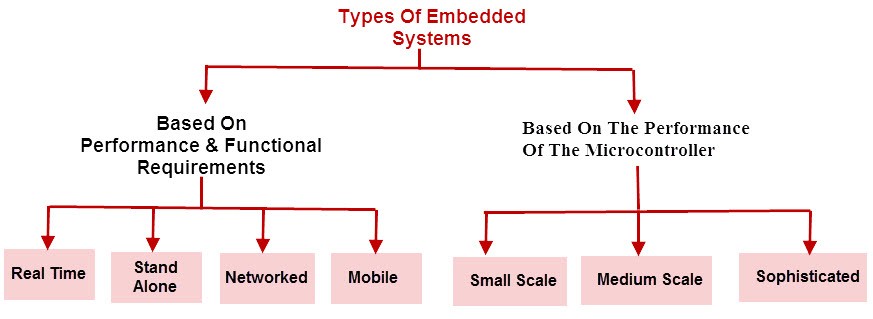
Types of Embedded systems
Embedded systems are classified into four categories based on their performance and functional requirements:
- Stand alone embedded systems
- Real time embedded systems
- Networked embedded systems
- Mobile embedded systems
Embedded Systems are classified into three types based on the performance of the microcontroller such as
- Small scale embedded systems
- Medium scale embedded systems
- Sophisticated embedded systems
Stand Alone Embedded Systems
Stand alone embedded systems do not require a host system like a computer, it works by itself. It takes the input from the input ports either analog or digital and processes, calculates and converts the data and gives the resulting data through the connected device-Which either controls, drives and displays the connected devices. Examples for the stand alone embedded systems are mp3 players, digital cameras, video game consoles, microwave ovens and temperature measurement systems.
Real Time Embedded Systems
A real time embedded system is defined as, a system which gives a required o/p in a particular time.These types of embedded systems follow the time deadlines for completion of a task. Real time embedded systems are classified into two types such as soft and hard real time systems.
Networked Embedded Systems
These types of embedded systems are related to a network to access the resources. The connected network can be LAN, WAN or the internet. The connection can be any wired or wireless. This type of embedded system is the fastest growing area in embedded system applications. The embedded web server is a type of system wherein all embedded devices are connected to a web server and accessed and controlled by a web browser.Example for the LAN networked embedded system is a home security system wherein all sensors are connected and run on the protocol TCP/IP
Mobile Embedded Systems
Mobile embedded systems are used in portable embedded devices like cell phones, mobiles, digital cameras, mp3 players and personal digital assistants, etc.The basic limitation of these devices is the other resources and limitation of memory.
Small Scale Embedded Systems
These types of embedded systems are designed with a single 8 or 16-bit microcontroller, that may even be activated by a battery. For developing embedded software for small scale embedded systems, the main programming tools are an editor, assembler, cross assembler and integrated development environment (IDE).
Medium Scale Embedded Systems
These types of embedded systems design with a single or 16 or 32 bit microcontroller, RISCs or DSPs. These types of embedded systems have both hardware and software complexities. For developing embedded software for medium scale embedded systems, the main programming tools are C, C++, JAVA, Visual C++, RTOS, debugger, source code engineering tool, simulator and IDE.
Please refer to this link to know more about Embedded Systems MCQs
Sophisticated Embedded Systems
These types of embedded systems have enormous hardware and software complexities, that may need ASIPs, IPs, PLAs, scalable or configurable processors. They are used for cutting-edge applications that need hardware and software Co-design and components which have to assemble in the final system.
Applications of Embedded Systems:
Embedded systems are used in different applications like automobiles, telecommunications, smart cards, missiles, satellites, computer networking and digital consumer electronics.
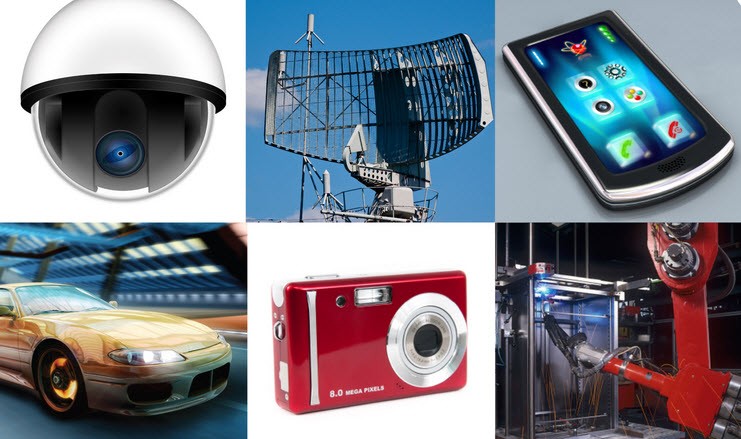
Applications of Embedded Systems
Embedded Systems in Automobiles and in telecommunications
- Motor and cruise control system
- Body or Engine safety
- Entertainment and multimedia in car
- E-Com and Mobile access
- Robotics in assembly line
- Wireless communication
- Mobile computing and networking
Embedded Systems in Smart Cards, Missiles and Satellites
- Security systems
- Telephone and banking
- Defense and aerospace
- Communication
Embedded Systems in Peripherals & Computer Networking
- Displays and Monitors
- Networking Systems
- Image Processing
- Network cards and printers
Embedded Systems in Consumer Electronics
- Digital Cameras
- Set top Boxes
- High Definition TVs
- DVDs
Please refer to this link to know more about Embedded Systems Role in Automobiles.
Please refer to this link to know more about VLSI Projects.
This is all about the embedded systems, types of embedded systems with their applications. We all know that these systems are extremely fabulous systems that play a vital role in many devices, equipments, industrial control systems, industrial instrumentation and home appliances irrespective of circuit complexity. Considering the huge significance of embedded systems, this embedded systems article deserves readers’ feedback, queries, suggestions and comments. Furthermore, for any queries regarding electronics projects, readers can post their comments in the comment section below.